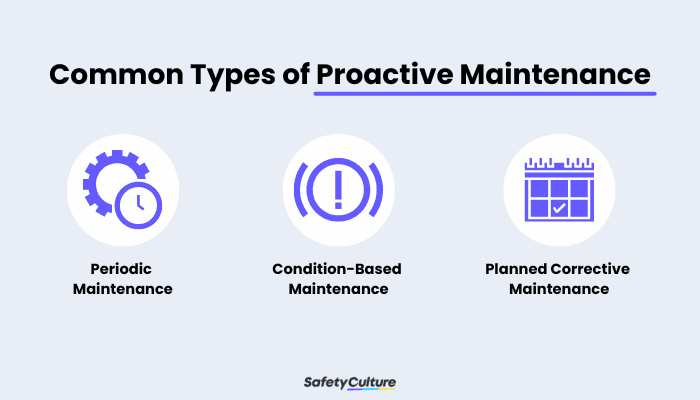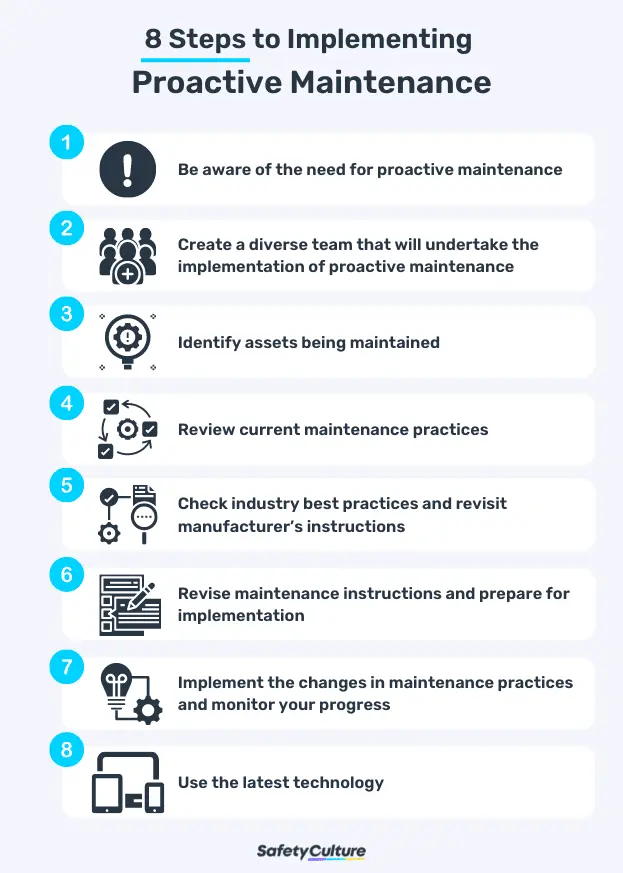What is Proactive Maintenance?
Proactive maintenance is a maintenance strategy that aims to determine the root cause of equipment failures in order to correct them before they cause more issues and lead to machine breakdowns. Implementing proactive maintenance in the workplace can boost productivity, maximize the use of assets, and contribute to workplace safety.
Why Is It Important?
Proactive maintenance is important because of these 3 main reasons:
- Proactive maintenance boosts productivity by making sure that equipment is at optimum performance and operations continue without unscheduled interruptions due to equipment failure or breakdown and other unforeseen issues.
- It maximizes the use of company assets by making sure that they are utilized well within their expected asset life, minimizing the need for the procurement of a replacement for equipment that finally broke down and can no longer be fixed.
- Proactive maintenance helps keep the workplace safe by making sure that equipment and other assets do not cause accidents due to malfunctions, failures, and breakdowns.
Proactive Maintenance vs. Preventive Maintenance
Both maintenance terms are used interchangeably but there is a difference between proactive maintenance and preventive maintenance. Here are their differences:
| Preventive Maintenance | Proactive Maintenance |
| Preventive maintenance is a recurring type of maintenance that usually follows a regular schedule. | The frequency of conducting proactive maintenance can vary depending on the need to address equipment issues. |
| The aim is to keep a machine or equipment working smoothly and prevent machine failure or breakdown. | The aim of proactive maintenance is to understand the root cause of an issue that could lead to equipment failure or breakdown and, with the help of data collected, fix the root cause. |
| An example scenario of preventive maintenance is an operator following the daily schedule of manually applying oil lubricant to an equipment’s chain before the start of operations or before 8 hours of continuous use. | An example scenario of proactive maintenance is carefully reviewing current maintenance practices and checking manufacturer’s instructions on maintaining equipment and learning that the recommended method of lubrication for a machine’s chain is via oil bath meant to be checked only once a year. |
Examples
Here are other examples of proactive maintenance:
- Checking pressure vessels, as a good example, to look for signs of corrosion or wear and tear in order to prevent dangerous accidents due to pressure vessel failure
- Conducting pipeline inspections to verify the integrity of a pipeline system and prevent expensive shutdowns due to failures caused by neglected pipes
- Cleaning, lubricating, and adjusting elevator components to solve recurring issues such as getting stuck in between floors during rush hour
Common Types
Here are the most common types of proactive maintenance:

- Periodic Maintenance – following manufacturer’s recommendations and using data collected over time on the use of equipment, scheduled maintenance checks are done at regular intervals to make sure equipment stays in good working condition
- Condition-Based Maintenance – real-time monitoring of certain parameters that would indicate if maintenance is due before any chance for an issue to occur
- Planned Corrective Maintenance – as part of condition-based maintenance, planned corrective maintenance involves doing corrective actions at a later, scheduled, date (due to current restrictions in resources such as budget, time, and manpower)
Achieve operational excellence
Cultivate a culture of excellence with our digital solutions that enhance efficiency, agility, and continuous improvement across all operations.
Explore nowSteps for Implementation
Here are some strategies on how to implement proactive maintenance in your workplace:

1. Be aware of the need for proactive maintenance
When maintenance is becoming more costly than it used to, in terms of time and resources, then it might be appropriate to consider getting to the root cause of maintenance issues and come up with long-term solutions.
2. Create a diverse team that will undertake the implementation of proactive maintenance
Include employees who can provide relevant contributions to the proper implementation of proactive maintenance. Those involved can be safety officers, equipment operators, maintenance technicians, operations leads, and those from the leadership team. Select a leader for this team.
3. Identify assets being maintained
Know which assets need maintenance and how important they are to operations. This can help prioritize which assets to focus on for proactive maintenance.
4. Review current maintenance practices
Carefully review current maintenance activities and assess which maintenance is most impactful. Take note of this along with the equipment being maintained to help determine which maintenance practices and equipment will benefit the most from the implementation of proactive maintenance.
5. Check industry best practices and revisit manufacturer’s instructions
Know if there are better ways to maintain equipment and if they were not yet applied in the workplace. Carefully review the manufacturer’s instructions on the maintenance and use of equipment to make sure that the right steps are being followed. Assess employee competencies when it comes to the use and maintenance of equipment.
6. Revise maintenance instructions and prepare for implementation
Now that you have reviewed current maintenance activities and compared them against the latest best practices and manufacturer’s instructions, prepare revised versions of maintenance procedures and include updated maintenance schedules as appropriate. Include all of these in an updated maintenance plan.
Create your own Maintenance Checklist
Build from scratch or choose from our collection of free, ready-to-download, and customizable templates.
Browse Maintenance Checklists7. Implement the changes in maintenance practices and monitor your progress
Once information dissemination is completed regarding the updated maintenance practices, start to monitor if the changes are implemented properly. Conduct inspections and also gather employee feedback on the impact of the changes and how those changes affected operations.
8. Use the latest technology: SafetyCulture (formerly iAuditor)
When it comes to implementing maintenance changes across the board and monitoring the current performance of machines and equipment in operations, companies can use SafetyCulture to make sure they have visibility. With SafetyCulture, companies can check if the changes implemented have a positive impact compared to previous processes and are proving more beneficial to operations.



